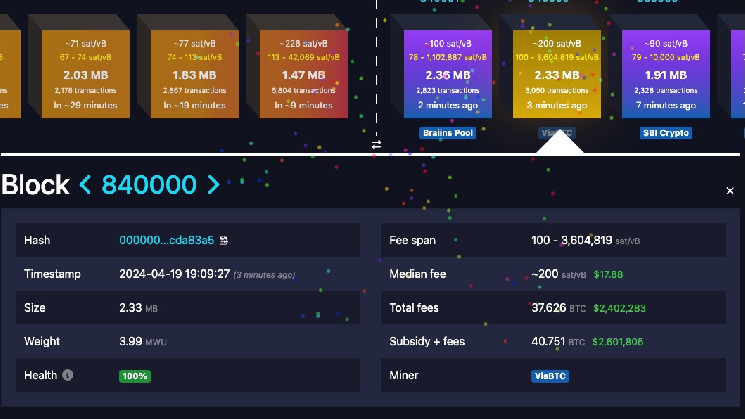The quadrennial event is seen as a momentous occasion in the crypto community.
Various factors may make this halving an event like no other in Bitcoin's history.
Soccer has the World Cup. Athletics and many other sports have the Olympics. Crypto has the Bitcoin halving.
The once-every-four-years bitcoin (BTC) reward halving took place at 00:09 UTC on Saturday, when the 840,000th block was added to the Bitcoin blockchain.
The halving, which cuts the reward bitcoin miners receive for adding new blocks by 50%, occurs every 210,000 blocks – in accordance with the original programming when the blockchain's elusive creator, Satoshi Nakamoto, launched it 2009.
This halving was the fourth in Bitcoin's history, with the reward dropping to 3.125 BTC.
For CoinDesk's complete coverage, please see our Bitcoin Halving landing page.
The mining reward is an incentive for entities who contribute computing power to secure Bitcoin. The miner that wins the race to add each new block to the network takes away the mining reward, the amount of which is fixed until it's cut again at the next halving, as programmed by the cryptocurrency's elusive creator, Satoshi Nakamoto.
The quadrennial event is seen as a momentous occasion in the crypto community because it symbolizes bitcoin's original concept as an autonomous, decentralized financial network whose monetary policy is set by code, as opposed to human organizations like governments and central bankers.
Unlike traditional, or fiat, currencies, whose value has historically been eroded by inflation and government printing, bitcoin is designed to be non-inflationary with a maximum total supply of 21 million BTC in circulation. With the halvings every four years, the pace of new issuance of bitcoins reduces over time until the last one is mined, likely sometime in 2140.
Read More: Bitcoin Halving, Explained
Historically, halvings have been followed by surges in bitcoin's price. The thinking is that the fewer new BTC are being produced, the more valuable those already in existence become. This time, the outlook is murky. Some market commentators say the halving is already priced into BTC and, therefore, the immediate effects may be muted. Others see the bitcoin price falling, while yet others have suggested a rally is in store.
The potential effects of this present halving may be impossible to predict due to the profound differences in the Bitcoin landscape compared with the three previous events. Notably, January's long-awaited approval of spot bitcoin exchange-traded funds (ETFs) in the U.S. means greater institutional investment is coming to BTC by orders of magnitude.
Also, following the launch of the Ordinals protocol early last year, there is now much greater activity going on under the hood of Bitcoin, with developments and upgrades to the network potentially bringing far more utility to the notoriously conservative ecosystem.
 coindesk.com
coindesk.com
